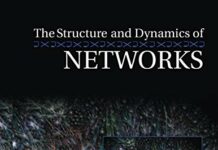
Ebook Info
- Published: 2012
- Number of pages: 561 pages
- Format: PDF
- File Size: 176.80 MB
- Authors: Mark Newman
Description
A complete introduction to the field of computational physics, with examples and exercises in the Python programming language. Computers play a central role in virtually every major physics discovery today, from astrophysics and particle physics to biophysics and condensed matter. This book explains the fundamentals of computational physics and describes in simple terms the techniques that every physicist should know, such as finite difference methods, numerical quadrature, and the fast Fourier transform. The book offers a complete introduction to the topic at the undergraduate level, and is also suitable for the advanced student or researcher who wants to learn the foundational elements of this important field.
User’s Reviews
Reviews from Amazon users which were colected at the time this book was published on the website:
⭐I studied computer science and physics at university, and I’m happy to say this is an excellent text if you’re interested in learning about one interesting cross-disciplinary intersection between the two. The book uses Python 3, and most of the sample code uses non-deprecated dependencies (most of the expired packages are in matplotlib).I found it guided me along just well enough so that I could complete most exercises without any high level of hand holding (some of the exercises can be done as mild alterations to the examples). While there are plenty of scientific computing packages out there that will do almost all of the behind-the-scenes heavy lifting for you, this book isn’t about using them — instead, it dives deep into the numerical computing methods often used by those same packages.There’s plenty of example programs to step you through the exercises. Also, if you have very little programming experience, the first chapter is committed to getting you caught up to speed, but if I’d have to recommend having at least some experience with programming before tackling this (a single introductory uni course, or some time with self-instruction learning python or some other language should be enough).Topics include Visualization, Accuracy and Speed, Integrals and Derivatives, Solving Linear/Non-Linear Equations, Fourier Transforms, ODEs, PDEs, and Monte Carlo/Random Methods.
⭐Four Stars for the excellent introduction to Python (+NumPy+MatPlotLib). It loses the 5th star only because loading a working copy of the full library package took a week of intense digging through obscure (to me) Python community developer websites which were less than friendly to the Python newbie. I’m on a fairly new 64-bit HP EliteBook 8770w running Windows 7. Finally found a workable combination of beta-test library modules in one place, and an 8-step loading procedure summary buried deeply in a user forum on another site. In all it took 14 builds to get one fully-functional Python+NumPy+MatPlotLib package. Guess I learned something from it but it took a lot of dogged determination. Now with a working software package I’m halfway through the book and learning a lot much less painfully. This is a fantastic step forward in programming tools for numerical design & analysis. And it’s all free if you can charge your time off to training. In my toolbox this will be my preferred environment for going beyond MathCAD and controlling threading in modern 4-Core CPU’s for 3-D transient magnetohydrodynamic modeling. – Don Cott, Thermal Systems Engineering, Anchorage, AK
⭐This is an incredible book for a first timer. It gives a very good introduction to the Python language and how to apply aspects of it to solving Physics problems.There are a few minor issues with the book (Not worth rating it lower than 5 stars). Dr. Newman will introduce libraries and not explain some of them, such as gaussxw. These are usually libraries and functions on the book website. However, there is no reference to it in the book when introduced. Minor oversite. Another issue is that there are parts of the book where it appears he didn’t pay attention to which values he was using.These are types of issues that I am sure will be fixed in later editions. Overall this is an incredible book. I picked up this book to see what it had to say. It has taught me things that I did not know. I love that!
⭐I like this book, but the physics is largely in the problems and not so much the text. The text is mostly organized by the features of the Python programming language (first four chapters) and then the pure mathematical concepts that are clearly programmable (chapters 5-10) rather than on the topics in physics to which they apply. There are some neat concepts in physics I did not know before reading the book (like the Madelung constant) but I am glad this professor from U. Mich. decided to write down some computational science concepts from physics given all the other attention on computational biology and chemistry.
⭐I absolutely love the physics in this book and it does a great job presenting a lot of the python concepts you will need to do amazing things. My only gripe is that it completely blows off object oriented principles and their benefits which is a crime. You will want to learn more about OO for larger scale and maintainable applications as you do more. Aside from that it is very well written and a pleasure to read and work with.
⭐Excelent! After decades using Fortran, accessing this book I wrote my first program in Python. It covers everyday problems in Computational Physics and use them as examples to apply Python programming.
⭐As Eric Ayars said, there are a lot of good books about Python, a bunch of good books about computational physics but we gota lack of book about comp. phys. using Python 3. That’s the one and it’s a real good one. I got only a suggestion: more practical exercises but, you know, if you buy this book you’ve advanced in this subject a lot of the road probably…
⭐I am a mathematician with some basic programing experience and I was interested in learning Python mostly for mathematical and educational purposes. I consulted many Python books, but I find myself returning over and over again to Chapters 2 and 3 of this book. If you are new to Python and you are interested in scientific applications this is in my view the best place to start.
⭐It’s a very good introduction for a beginner in computing and python is a very useful language
⭐An absolute classic for anyone who wish to explore programming for application in physics.
⭐This is a very clearly written introduction to computational physics. It includes such modern topics as Fourier Analysis and Random Numbers, which are typically absent from computational physics books, without sacrificing the discussion on traditional topics such as linear algebra and differential equations.The tone of the text is that of a friendly teacher. Very often, computational physics textbook get drowned with unnecessary and dry discussion on algorithms and errors. Newman realises that while such discussion is important it can also unnecessarily repel the new student. Unnecessarily, because we now live in an age where Python and Numpy have made computational physics a joy instead of a chore.Newman embraces the Python programming language. He describes each concept with a small Python implementation. He also discusses library functions available in the Python standard library and in Numpy or Scipy. There is useful discussion on how to use Python and how to install it on your computer.There are not many but very useful and elaborate exercise problems.Do not be worried that this book is self-published. I highly recommend it for college students for their self-study. This book and a laptop with Python installed is a perfect set-up for any student to master computational physics. I also used this book recently in a course I gave to PhD students to good effect.
⭐The book itself looks very resourceful and good for academic and professional purposes. The only thing is that it was received with a big fold. This is probably due to the poor protection of the type of envelope used to send it. Since this is a book that I will be using my whole life, this greatly shortens the lifespan of this book. This is why I gave 1 star.
⭐Very well written. Lots of exercices, problems, and digital resources. However, the visual tools used in the book are outdated, and it doesn’t use matplotlib. The book uses python3, but the focus is not so much about proper coding.It does covers all the important topics in computational physics, and is thus a wonderful resource for teaching.
Keywords
Free Download Computational Physics in PDF format
Computational Physics PDF Free Download
Download Computational Physics 2012 PDF Free
Computational Physics 2012 PDF Free Download
Download Computational Physics PDF
Free Download Ebook Computational Physics

